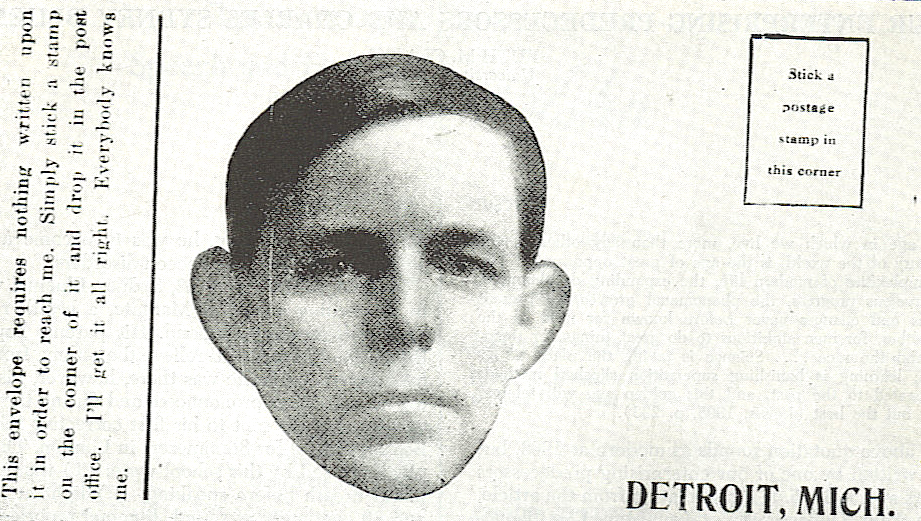
The following is a feature article which was first published in the ASHA Magazine, April 1964, p. 107-114. It is reprinted below with permission of ASHA.
The age in which we live, more than any other in the history of the world, is the age of great opportunity. The vast complexities of modern life, the expanding development, the marvelous progress, the phenomenal growth, all present demands and chances never before known for men of the right caliber, for men ambitious to do great things for themselves and the race.... Science is taking the place of ignorance; learning is banishing superstition slipshod methods are relegated to the past, and this golden age will tolerate nothing but the best (Lewis, 1905, p. 233).
The above quotation sounds as modern as 1963, but it was written by one of our enterprising predecessors 59 years ago, in 1905. It is a quotation from the article, "Grasp Your Opportunity," taken from The Phono-Meter, a publication of the George Andrew Lewis School for Stammerers in Detroit, Michigan. A copy of this early journal is but one priceless item in the large collection of memorabilia of speech correction made by the late Charles Sydney Bluemel,1 whose widow presented the collection to the author. Bluemel's collection provides an invaluable historical documentation, not only of the forerunners of speech pathology in this country, but also of his own lifelong search for a cure for stuttering.
The story of this search can be read in the letters, brochures, clippings and catalogs of the file. Much of this is also told in a rare collection of books on stuttering which Bluemel gave to the University of Denver library (Murray, 1957). His own life stoiy has been told by James M. McDearmon (1960) who was fortunate enough to have interviewed Bluemel at great length before his death. McDearmon's study and the yellowing papers of both collections cast light on the growth of the profession of speech pathology over the years.
Oddly enough, it was the same Lewis School for Stammerers that first brought Bluemel to the United States from England in 1906. As far back as he could remember, Sydney Bluemel had stuttered. As a child he was not too concerned about it. He told his biographer, "I wasn't bothered any more about speech than I was by dirty hands" (McDearmon, p. 11). Nevertheless, he became more aware of his problem as he grew older, and his speech difficulty influenced his entire life, including his choice of profession, psychiatry. Motivated by a need to understand the dynamics of stuttering, he was to become a leading authority in the field of speech disorders.
In 1896, at the age of 12, Sydney Bluemel was sent to a boarding school at Margate, a health resort on the south coast of England. His parents hoped that the climate there would relieve the asthma from which he suffered. While he was there, however, his stuttering became more pronounced, and during the summer vacation he was sent to his first corrective school, the Beasley School for Stammerers in London. The principles endorsed by this school were: (1) the use of the initial breath before speaking; (2) light articulation; and (3) continuity of sound. Bluemel reported that he improved greatly while at the Beasley School; but back at the boarding school he stuttered as much as before. He recalled saying when the headmaster asked if the doctor had cured him, "I quickly demonstrated that he hadn't" (McDearmon, p. 14).
After graduating from Margate and spending a year in Germany to improve his German, he worked for three years as an apprentice in the family firm known as Bluemel Brothers, manufacturers of bicycle and automobile accessories. It was in 1906 that he obtained a copy of an American magazine with an advertisement of the Lewis School in Detroit, which guaranteed to cure stammering. He was impressed. In England, one could rely upon an advertised guarantee, and he naively supposed that the situation would be identical in America. At 22, he hopefully left England to attend this school.
A Lewis School announcement for the summer session (1905) is found in Bluemel's collection, and may well be the one, which encouraged him to come to America. It says:
The Lewis School was established in 1894. In eleven years it had become widely known, at least in its own modest estimation, as evidenced by its return envelope, on which for the address was printed nothing but a picture of Mr. Lewis, and the name of the city--Detroit, Michigan (Figure 1).

George Andrew Lewis (Detroit News, 1905) was hardly notable for modesty and timidity. He termed himself, "The World's Greatest Speech Specialist" in a brochure of 1905, which reproduced clippings from the Detroit News and contained pictures of his students. In one class portrait, 156 men and women, boys and girls, were shown. The method taught at the Lewis School was to enunciate syllables as the arm was swung in a figure eight pattern. After exposure to this system, Bluemel felt the cure was worse than the disease. He preferred his stuttering to the pattern. It was at this time, in a reaction against such superficial treatment, that he first began to crystallize his own ideas on a nonorganic basis of stuttering. While at this school, he and other dissatisfied students experimented with Bluemel's idea of negative practice and several other methods, but none proved effective. Disenchanted and discouraged after three months at the school, he left it and went west to Denver in hopes of finding relief for his ever-present asthma. There he seemed free of his asthma, and thinking that he would no longer be afflicted with it, he returned to England to resume his work with the family firm. It was not long before it reappeared, and in addition, he developed tuberculosis. Knowing from experience that his health was greatly improved in Colorado, he decided to emigrate there, but not before he had settled his score with George Lewis.
Prior to leaving for the United States, Bluemel wrote to Lews "that he would be stopping off in Detroit to sue him for the return of fees obtained under worthless guarantee" (McDearmon, p. 16). Lewis' attorney responded with a letter accusing Bluemel of blackmail, but despite this, the outraged Bluemel went to Detroit and demanded his money. Actually, he recalled, the threat to sue was only a bluff--but the bluff worked. Lewis refunded all his tuition.
COMMERCIAL SCHOOLS
Bluemel's collection includes literature of the commercial stammering schools in the United States, England and Europe. A review of the letters, brochures and catalogs of these schools provides a fascinating aspect of the history of the development of speech pathology over the years.
From this literature it seems that in the United States, Detroit was the most fertile field for the establishment of schools to correct stuttering. In addition to the Lewis School, which has been mentioned, The Reed School, with the motto, "A Square Deal for All," produced a lasting effect on the Detroit Educational system. The following appeared in bulletins and announcements (1907) of the Reed School:
Before the Reed Method was brought to its present state of perfection, no entirely satisfactory plan of correcting stuttering and stammering had ever been devised, although scientists and educators had made progress along certain lines of thought, yet it remained for the Reed School to offer to the world the one, true, natural and scientific method of speech correction.
A Reed School brochure read, "Only natural speaking is taught or allowed. Positively no use is made of drawling, beating time, sing-song speech or any other trick" (1907). A blotter was distributed showing the unnatural methods of "fake schools." (Figure 2)
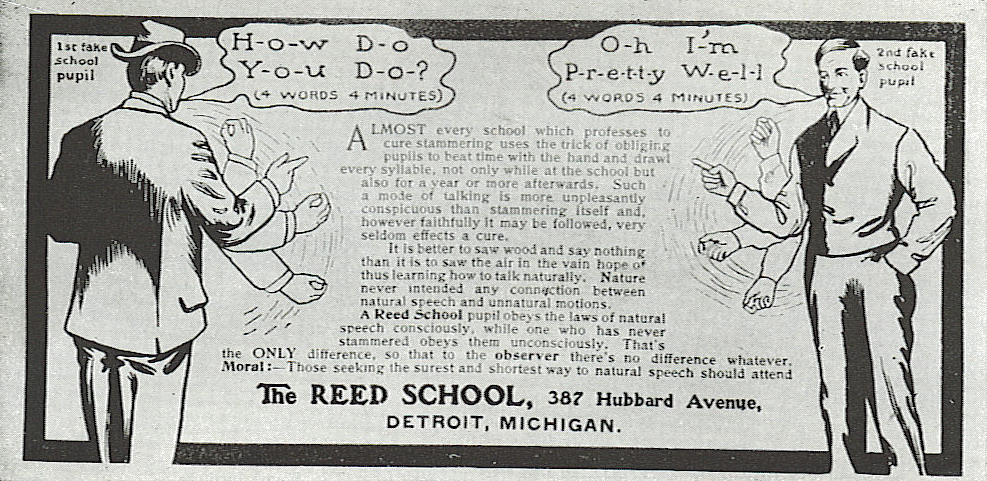
Another publication of theirs, in 1905, composed of testimonials, was entitled, "Pen Pictures of Pleased Pupils" (Reed, F., 1905). Frank Reed, director of the Reed School and a corrected stutterer himself, often talked to his wife about the problems of young children who stuttered, and wished he could do something to help them overcome their speech problems. In 1909, after her husband's death and four years of planning, Mrs. Reed went to her former classmate and close friend, Walen C. Martindale, Superintendent of the Detroit Public Schools, with a proposition that as a memorial to Mr. Reed, "she wished to train, free of charge, two public school teachers to incorporate the Reed Method of the correction of stammering in the public schools" (Ryan, p. 3). After much publicity and discussion for and against the offer, it was finally accepted by the Board of Education Committee on Teachers. "Mr. George Lewis of the Lewis Institute, an adult school for the correction of stammering, was one of the most violent objectors to Mrs. Reed's plan" (Ryan, p. 4).
In June 1910, Clara B. Stoddard and Lillian Morley were selected to be trained by Mrs. Reed in the Reed Method for the collection of stammering. After intensive study with Mrs. Reed during the summer, two speech centers were opened in September by Stoddard and Morley. Thus was born, over fifty years ago, the Speech Correction Department of the Detroit Public Schools (Ryan).
Soon after the turn of the century, March 8, 1901, an enterprising citizen of Indianapolis, Indiana, Benjamin M. Bogue, started another institute for stammerers. The early literature and advertisements from the Bogue Institute are ingenious and interesting. All of them contained a guarantee, such as the following:
I hereby guarantee that I will positively and completely cure every case of stammering or stuttering that I accept for treatment in my Indianapolis Institute. It makes no difference what were the original causes of your stammering. I will restore you to perfect powers of speech or I will refund every cent you pay me in tuition. This guarantee is your protection; moreover, it shows my confidence in the absolute infallibility of my methods. Remember you run no risk whatever. Either I make you talk as well as anyone or your tuition costs you nothing. Could anything be fairer than this? Therefore, take heart and come to me at once. Your cure is certain. I have cured hundreds of stutterers and stammerers. I have never yet had a failure or a relapse when my instructions have been followed (Bogue, 1909).
One of the most interesting letters which Bluemel received from the Bogue Institute was sent in 1911 (Bogue, 1911). The envelope pictured the roads of perfect and stuttering speech (Figure 3).
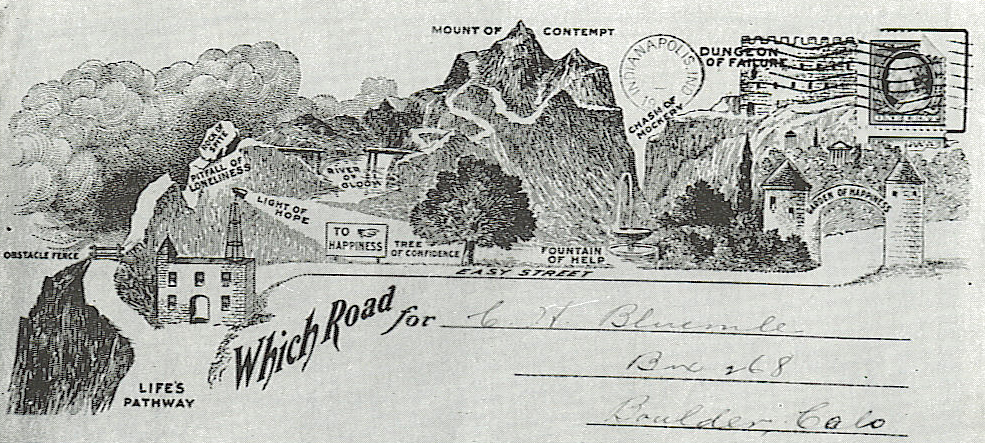
Inside was an explanation of the picture (Figure 4).
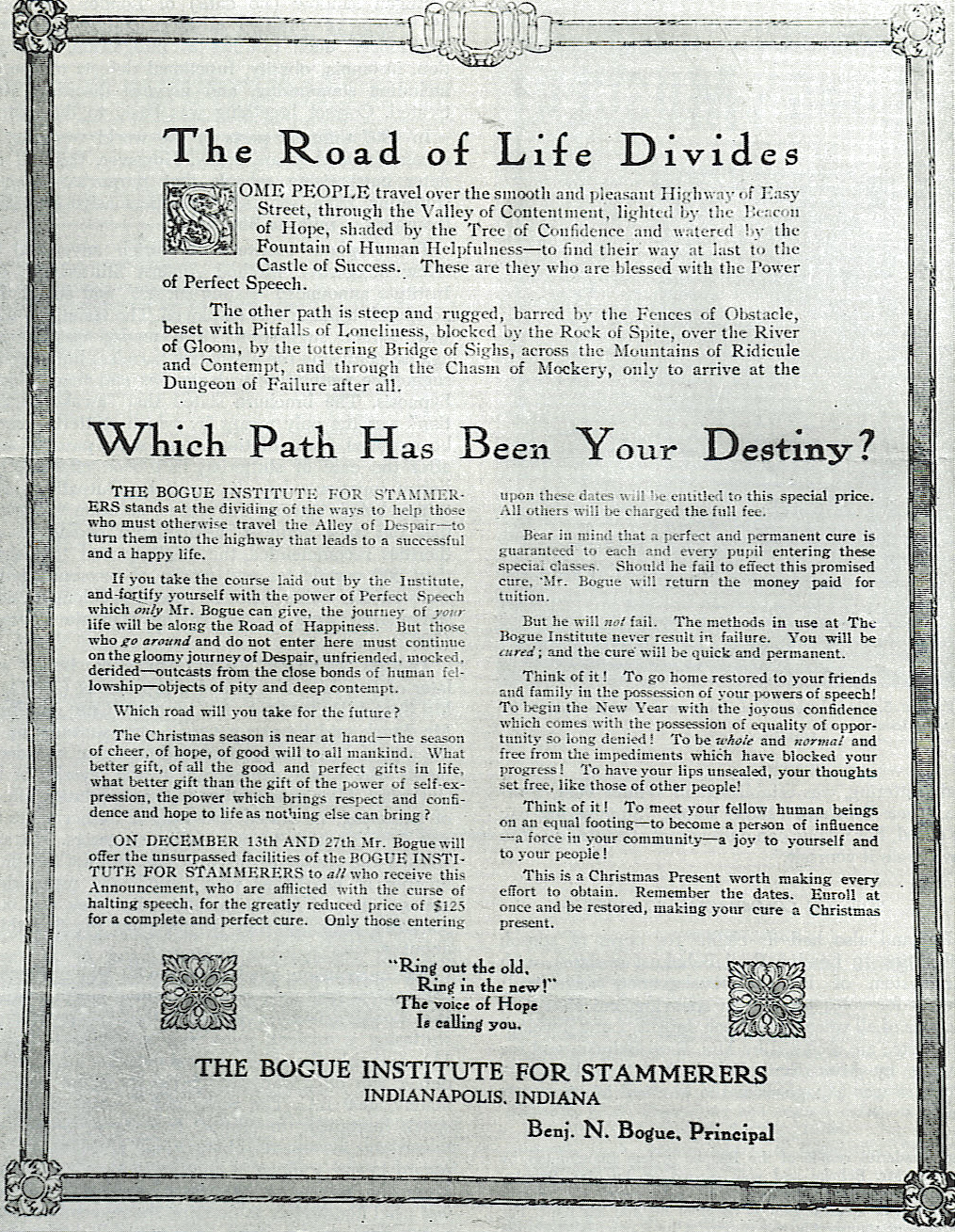
Another of the early schools for stammerers was the Philadelphia Institute. This pioneer endeavor started in 1884. Also in Philadelphia was the Carswell Institute founded in 1871. This stammering school advertised its method as, "the cure that cures." A 1905 booklet from this Institute describes, "The Wonderful Fon-Lin Method, the only scientific, natural, perfect, permanent remedy for stammering, stuttering, lisping, tongue-tied talk and all impediments of perfect speech" (Carswell, p. 1).
A woman from Newton Centre, Massachusetts, E. J. E. Thorpe (1890), along with her lectures on the speaking voice and reading selections from Browning, published a small pamphlet, "Speech Defects, their Causes and Correction." She ran a "vocal school for the correction of stammering and other defects of speech."
Correspondence schools as well as those recommending breathing exercises were well represented in Bluemel's files. Paul von Boeckmann (p. 8), a respiratory specialist of New York (Figure 5), in his booklet and course on diaphragmatic breathing wrote:
My system of correspondence instruction is perfect. ... I have taught over 23,000 persons by correspondence and have long ago overcome all obstacles that might make my instructions less comprehensive, and less effective.
He sold the "Pneumauxetor," a breathing machine, and his complete course for $15.

Among the literature from correspondence schools for the correction of stammering was material from Walter McDonnell (1913) of Washington, D. C. He offered a ten-week correspondence course, which included the "Natural Vowel Method." The cost was $15. McDonnell had the usual testimonials in his literature, but his guarantee said:
Neither I nor any honest man can GUARANTEE to cure any person of stuttering and stammering, because a permanent cure rests entirely with the pupil--not with the teacher. Every stammerer must cure himself or herself; no teacher can do it for a pupil. It is a voluntary act, made possible by causing the pupil to understand WHY the speech impediment occurs and then showing HOW it can be corrected and permanently stopped. McDONNELL'S CORRESPONDENCE COURSE does that, and no other school or institution in the world can do more.
The Denver School for Stammering with Albert V. Hines, a recovered stammerer, as principal and founder, tried to put the Golden Rule into practice. Hines wrote:
There is probably nothing in this life which is more fully satisfying than the feeling that we are doing, or at least making an honest effort to do, a real service for the benefit of cur fellowmen. It has been truly said that everyone has some great mission on this earth to perform and the fulfillment of it in the broadest sense is surely deserving of the highest commendation we can possibly give to it. Our own good and that of our fellow-beings bind us to this duty. Having suffered very much through life from stammering and sympathizing deeply with the numerous sufferers who are everywhere to be met with, I feel it my duty to give, for the benefit of others, the result of my experience and observations. With an ever deepening sense of gratitude to be really useful and add to the sum of human happiness have inspired the labors herein expended. Guided by sincerity, honesty and ability and with a fervent desire to fulfill the Golden Rule to the utmost, I take up this life work.
Lee Wells Millard (1909), President of the Northwestern School for Stammerers in Milwaukee, announced a special class and reduced summer rate. He said in his publicity, "For years our school has enjoyed the reputation of conducting the foremost, standard and reliable institution for the cure of stammering on this Continent."
The Connecticut School for Stammerers and Stutterers diagnosed by mail. From "the Stammerer's Symptom Sheet" (Bellerose), a written diagnosis and terms were given, and the time necessary for a cure determined (Figure 6).
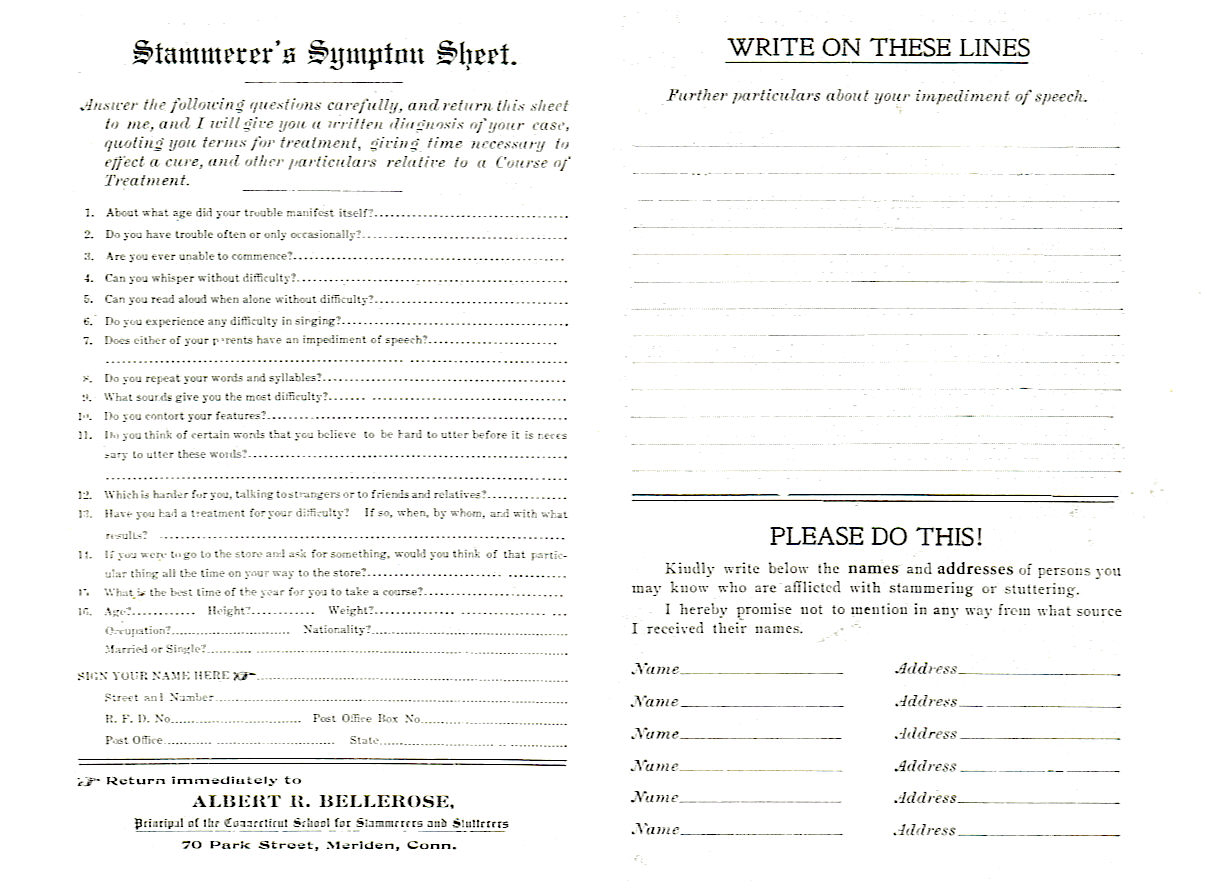
The Principal of the Connecticut School, Albert R. Bellerose (1915), originated the "famous Bellerose Psycho-Phonic Method for the cure of stammering."
As late as 1935 the Emery-Lewis School, a correspondence school for the correction of stammering and stuttering, was established in Winter Park, Florida. Their Brochure (1935) stated, "Stammering can be cured, but no one can cure you of stammering. You have to do it yourself."
FOREIGN COMMERCIAL SCHOOLS
England also had its claims for cures of speech difficulties. In London Emil Behnke (no date), with her system of Breach Development, advertised: "Pupils for voice training in speaking and elocution, the care of all voice and speech defects, Lung development, etc., are received by Mrs. Emil Behnke; and for singing by Miss Emil Behnke." Attached to the brochure was a page from the Medical Magazine. It read:
The wonderful results of the Behnke system Inaugurated by the late Mr. Behnke and now carried on by Mrs. Behnke, have attracted the attention and commanded the recommendation of medical men as no other method has done. For the cure of stammering the system of lung gymnastics proves usually perfectly adequate, and great improvement in the voices of those who are entirely deaf has been effected by a combination of breathing and voice exercises.
Eugen Sandow (no date) of London developed "A system of curative physical culture by correspondence." Such troubles as indigestion, constipation, insomnia, obesity, functional defects of speech, including stammering, and nervous disorders were treated. Correct breathing was basic to the system.
In 1907 different parts of the world were not as accessible as they are today. However, this did not deter enterprising schools that purported to cure stuttering from sending their persuasive literature thousands of miles to Bluemel.
The Hephata Institute of Zurich advertised its "New Suggestive Method Against Stuttering." The Institute announced "lasting success" and stated that no speech training was employed. The technique used was "awake suggestion." The reader was warned against confusing the absolutely harmless but effective suggestive method with dangerous and demoralizing hypnosis. The brochure stated that "awake suggestion" was the only means by which stuttering could be removed for a lifetime. Fees were payable only after the cure of stuttering had been effected, but before inpatients left the Institute. Outpatients had to pay before starting the course. Mention was made that the most eminent medical and pedagogic authorities recommended the Institute and that more than 500 certificates and letters of recommendation were on file. Other types of speech problems besides stammering were treated at the Hephata Institute (1907).
Another European, Hans Muck of Bonn, and later of Potsdam, also issued a prospectus (1907), of his Sprach-Heilinstitut, i.e., Speech Cure Institute. Mr. Muck said he was a very severe stutterer up to the age of 26 years. He included copies of two documents, which gave evidence as to the severity of his stuttering. After commenting on the devastating effects of stuttering, he stated that only a former stutterer was in a position to cure other stutterers. He also warned the reader of his brochure against the great number of charlatans who periodically make their appearance and falsely maintain that they can cure stuttering, although they do not know the first thing about it.
The enterprising predecessors with whom Bluemel had contact spanned a period of almost half a century. We should remember, however, that the problem of stuttering is ancient. According to Calzia (1941, p. 11), probably the oldest written evidence of a speech defect was on a papyrus written in Egypt approximately 2000 B.C. The verb "nitit," which means to speak hesitantly, to stutter, had its origin in the "retarding movement of walking, and is used in regard to the 'walking of speech.' A term, which had originally pictured the retardant stepping of the legs, was used figuratively to describe the movement of the tongue."
The references and figures presented are representative of the items in Dr. Bluemel's collection. One can speculate how they must have spurred him to search for a more scholarly and scientific theory of stuttering and its treatment. Up to the time of his death in 1960, at 76 years of age, he was still actively seeking, discussing and probing the "Riddle of Stuttering."
ACKNOWLEDGEMENT: The author wishes to acknowledge indebtedness to Dr. James McDearmon, from whose dissertation much of the biographical data were taken for this article. Also an acknowledgement is due Dr. G. H. Breckwolclt, formerly of the University of Wit-watersrand, Johannesburg, South Africa, and now at the St. Louis University, St. Louis, Missouri, for translating references 12, 22, 28, and 29.
b\Behnke, Dmil, Behnke's system of breath development for voice training. London (No date).
Bellerose, A. R., Advertisement for the Connecticut school for stammerers. Meriden, Connecticut (1915).
Bellerose, A. R., Stammerer's symptom sheet for the Connecticut school for stammerers. Meriden, Conn. (No date).
Bogue, B. N., A special offer to.... Indianapolis (1909).
Bogue, B. N., The road of life divides. Indianapolis (1911).
Bluemel, C. S., Stammering and cognate defects of speech. New York: G. E. Stechert, 2 Vols., (1913).
Bluemel, C. S., Mental aspects of stammering. Baltimore: Williams and Wilkins, (1930).
Bluemel, C. S., Stammering and allied disorders. New York: Macmillan, (1935).
Bluemel, C. S., The troubled mind. New York: Williams and Wilkins, (1938).
Bluemel, C. S., Psychiatry and common sense. New York: Macmillan, (1954).
Bluemel, C. S., The riddle of stuttering. Danville, Illinois: Interstate Press, (1957).
Calzia (Panconcelli-Calzia), G., Geschechtszahlen der phonetik, 3000 Jahre Phonetik, Hansischer Gildenverlog, Hamburg (1941).
Carswell, E. R., "A boon for stammerers, not bettered but cured." The Carswell Institute, Philadelphia (1905). Detroit Neivs: Clippings and pictures of the Lewis School. (1905).
Emery-Lewis School Brochure, Winter Park, Florida (1935).
Hines, A. V., The Denver school for stammerers. (No publisher nor date).
Lewis, G. A., The phono-meter. IX, No. 10, Detroit, Michigan, October (1905).
Lewis School Summer Announcement. Detroit, Michigan (1905).
McDearmon, J. R., A study of the development of Dr. C. S. Bluemel's theories of stammering. Unpublished Dissertation, University of Denver, (1960).
McDonnell, W., Stuttering and stammering, how I cured myself at home. Copyright by Walter McDonnell, (1913).
Millard, L. W., The Northwestern school special summer announcement for 1909. Milwaukee, Wisconsin.
Muck, H., Prospekt des Bonner Sprach-Heilinstitut Hauptmann sche Buchdruckerir in Bonn (1907).
Murray, E., The C. S. Bluemel collection on stuttering. J. Speech Hearing Dis., 22, 5, December (1957).
Reed, F. A., Pen pictures of pleased pupils, Detroit (1905).
Reed School, What are you going to do about it? Detroit (1907).
Ryan, Elise, A history of the Detroit speech correction department. Unpublished paper.
Sandow, Eugen, The Sandow curative treatment by correspondence from the medical point of view. London, Gale & Polden, Ltd. (No date).
Schonfeld, Neumann-Von, Hephata, Anstatt fur Stotterer, etc. Grenclien, Buchdruckerei A., Niederhauser (1907).
Schonfeld, Neumann-Von, Eine Neue Stuggester-Methods Gagen das Stottern. Anstatt Hephata in Zurich (1907).
Thorpe, E. J. E., Speech defects, their causes and correction, Philadelphia, American Printing House (1890).
Von Boeckmann, P., Breathing for health, strength and vitality. (No publisher or date).
added January 14, 2005, with permission of ASHA